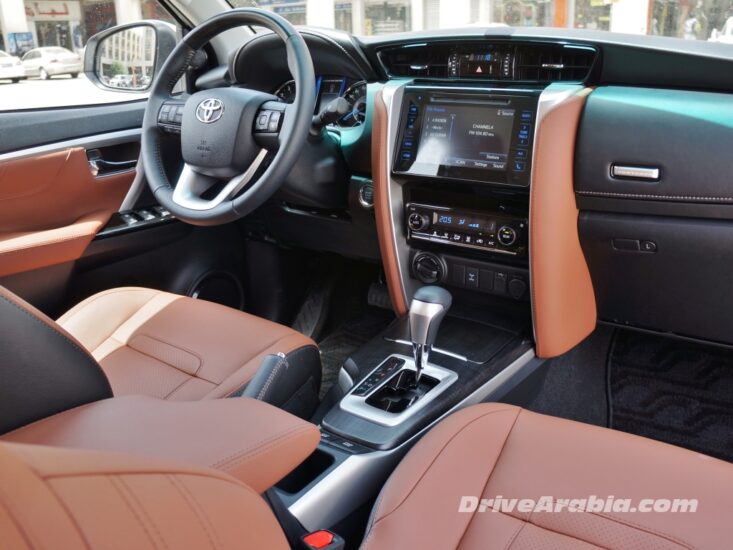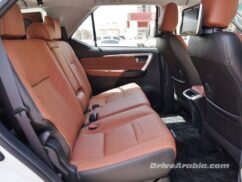2017 Toyota Fortuner

| The Good: – Great styling inside and out – Fair space and features – Great offroader |
The Bad: – Limited third-row legroom – Lazy steering and gearbox – Rides a bit stiff |
The Toyota Fortuner is so popular in the UAE that in terms of sheer numbers, it is second only to camels. After years of playing the second fiddle to its overpriced big brother, the Prado, as a cheaper-yet-capable alternative, the Hilux-based Fortuner even looked cheap, sharing design cues with its workhorse pickup sibling more than any other Toyota. But after a massive overhaul for the 2016 model year, the all-new Toyota Fortuner still doesn’t share any styling cues with any other Toyota. It looks better than all of them.
Based on Toyota’s current ‘keen look’ corporate design theme, the Fortuner no more looks like an offspring of the Hilux and the Innova, even those all three share a body-on-frame chassis. Sporting sleeker headlamp units housing the LED daytime running lamps and the optional bi-beam LED headlights, thin tube-LED tail lamps, muscular front bumper and a flowing side profile with the window-line raised towards the rear, the new Toyota Fortuner is a massive step up in terms of styling, looking best in top-spec trim.

Inside, Toyota has decided to ditch at least some of the hard plastics in favour of padded leatherette surfaces for some parts of the sculpted dash, doors and even on the centre-console. Overall, the fit and finish is excellent. It even boasts several new convenience features never seen before in the picked-based SUV segment, such as a glove box cooler, paddle shifters, and an optional 8-inch capacitive touchscreen navigation system alongside the optional independent rear entertainment system.
Other available features include smart keyless entry with push start button, electric liftgate, follow-me-home lighting, front and rear fog lamps, rear parking sensors with reverse camera, 6-speaker audio system with Bluetooth streaming, USB and AUX support, steering wheel controls for audio, sliding front center-armrest, covered cup-holders for front passengers, and automatic dual-zone a/c with ceiling-mounted rear controls and vents for second and third row passengers. There is no sunroof offered at all. Standard safety features include a tyre pressure monitor, stability control system, front airbags and a segment-first knee airbag for driver, although oddly skipping side/curtain airbags.
The new Fortuner has slightly grown in size too, with more space especially in the second and third row, although the third-row seating can just about cram in average-sized adults if the second row is moved forward. Access to the third-row is easy due to the sliding second row, although stepping in almost requires a mini ladder, thanks to the Fortuner’s ride height. However, even with all three rows up, there is still enough space in the boot to hold grocery bags.
The comfortable front seats are moderately bolstered, while the second row bench 60:40 split-folds into the floor, while the old-fashioned third-row seats fold up to the sides, which wastes cargo volume in an otherwise massive boot. There are cup-holders for occupants in all rows, multiple 12V power outlets, two glove-boxes in the dash, and storage pockets in all doors. There are pockets and even convenient bag-hanging hooks on the front seatbacks.

Powered by old engines carried over from its predecessors, namely the 2.7-litre 4-cylinder unit generating 164 hp at 5200 rpm and 244 Nm of torque at 4000 rpm, and the 4.0-litre six-cylinder unit capable of 235 hp at 5200 rpm and 376 Nm at 3800 rpm, the real change in mechanicals lie in the drivetrain configurations of the new Fortuner. While both the engines are now mated to a standard 6-speed automatic transmission, the new Fortuner is now available only with part-time four-wheel-drive, bidding goodbye to the useful all-time all-wheel-drive configuration used in its previous generation. This means, it can only be run in two-wheel-drive mode on the road, while four-wheel-drive operation is strictly confined to offroad surfaces.
Expectedly the V6 powertrain offers good low-end torque and commendable all-round performance both on and off the tarmac, while the 4-cylinder version is the better choice for the city whilst still being capable of some moderate off-road excursions. The advantage of those extra gears is evident especially in the 2.7-litre variant of the Fortuner, both in terms of fuel efficiency and acceleration.
While the new 2.7-litre Fortuner may still not be a remarkable performer, it has improved over its predecessor, doing the 0-100 kph dash in under 13 seconds and recording a combined fuel burn rate of 12.6 litres/100 km during our test last August. The heavier 6-cylinder variant does the 0-100 kph acceleration in an unimpressive 9.8 seconds, while posting the fuel burn rate at a ho-hum 14.5 litres/100 km, although it can be as high as 20 litres/100 km in aggressive driving.
While the upgrade to a 6-speed transmission is a praiseworthy move, the transmission unit itself appeared to be a rather casual and lazy unit, as if tuned for extreme efficiency, even when driven in regular drive mode. There is an ECO mode to make things even more lazy in the name of saving a few teaspoons of fuel. In manual mode, paddle-shifting doesn’t do any wonders as the shifts are noticeably delayed and is not of much use in situations where gear shifts need to be instantaneous, especially in off-road scenarios. To make matters worse, the 2.7’s gearbox never seemed to find the right gear while negotiating city traffic congestion, occasionally going into an upshift-downshift spree. The 4.0 V6’s gearbox doesn’t need to hunt gears as much, due to the torquey engine doing all the pulling.
It is on the road where the new Fortuner makes its truckish roots evident. While the ride quality has improved quite a bit, it still makes most road imperfections felt in the cabin, along with some occasional mild judders, thanks to a somewhat stiff suspension and live rear axle setup. The beefy 265/60 off-road tyres on the top-spec V6’s 18-inchers does help a bit in cushioning out some of the vibrations though, making for a somewhat floaty ride. Nevertheless, it is fairly bearable on long drives. Inside the city, the tall driving position aids all-round visibility.
The new Fortuner is reasonably quiet all the way up to 120 kph, after which wind noise starts becoming obvious. Road noise is nearly absent, while the industrial-sounding engine’s noise is evident only on throttle application.
Body roll reaches moderate levels at most, which is not bad for an SUV with such an overly tall profile. Handling is decent too, with no noticeable untoward behaviour during sudden steering inputs. But the steering is lazy and feedback is almost nil, while the brakes feel mushy too, even while providing very good stopping power. The controls makes for a slightly truck-like driving experience, but less so than the old model.
Off the tarmac the Fortuner continues to shine as always, just like its predecessor. With a ladder-frame construction, live-axle rear, very good approach and departure angles, and low-range gearing, even the four-cylinder version is a very rugged vehicle that can venture quite deep into the wilderness with the right person behind the wheel. However, the six-cylinder version boasts a lot more torque, and gets a rear differential-lock as well in the higher trims, is the obvious choice for more serious off-roading.
The Toyota Fortuner has been a success story in the GCC since its inception a decade ago. The all-new second-generation model is a lot more than just a pick-up in disguise. It even looks and feels different from its commercial cousin whilst being equally rugged and capable offroad, and much better on the road.
| Price Range: Dh 109,900-145,000Current Model Introduced in: 2016 Body Styles: Engines: Transmissions: Setup: Suspension: |
Brakes: Front: discs Rear: discsCurb Weight: 1765-1845 kg Length: Wheelbase: Top Speed: Test Acceleration 0-100 kph: Observed Test Fuel Economy: |
















Comments
Mashfique Hussain Chowdhury
More photos:
https://www.drivearabia.com/news/2017/03/16/so-we-got-a-2017-toyota-fortuner-dubai-uae/
Vivian
I think the New 2017 Chevrolet Trailblazer is better spec vehicle than the New Fortuner at this price point .
iraqi
120 Volt !! what ??
Thanks. Corrected. — Ed.
Silver
Can you do a review on the Mitsubishi Montero Sport – full option as your next review car, if possible. Thanks
MSI
Hi Mashfique, please tell me one thing, thast I have 4×2 Fortuner with 2.7 Engine, can I take my vehicle for off roading, and if yes then to what extent.
Mashfique Hussain Chowdhury
Just gravel and very firm flat sand.
MSI
Hi Mashfique thanks for the reply can you please tell that can I take my 4×2 fortuner to mountains or Mountainous area mean where we have high steep mountains, like sudden steep downward or upward, I know that 4×2 is not for desert.
Plus can you do review of 4×2 Fortuner.
Mashfique Hussain Chowdhury
Not recommended for steep climbs.
Hussam
Its a shame that there aren’t any options for a sunroof/panoramic roof. Also no side air bag system of any sort. Not to leave out 6 speed is adequate but outdated nowadays
Ashwini
Technically is Fortuner V6 4l lower version with 17inch tyres better than the full option with 18inch ?Besides the looks- full option gives Leather seats and 18inch tyres .Confused if you can leave leather seats aside-do 18inch tyres give a big advantage?
malek
I don’t understand why some people buy this.
Farhan
Because it has resale value.
UMARFARUK
Muscular Model made by Toyota
Kiran Krishnan
I am planning to purchase a 2017-2018 model Fortuner 2.7 liter. I drove 4.0 liter Fortuner 2018 and its powerful but i heard 2.7liter is very lagging. Can you advise about the power